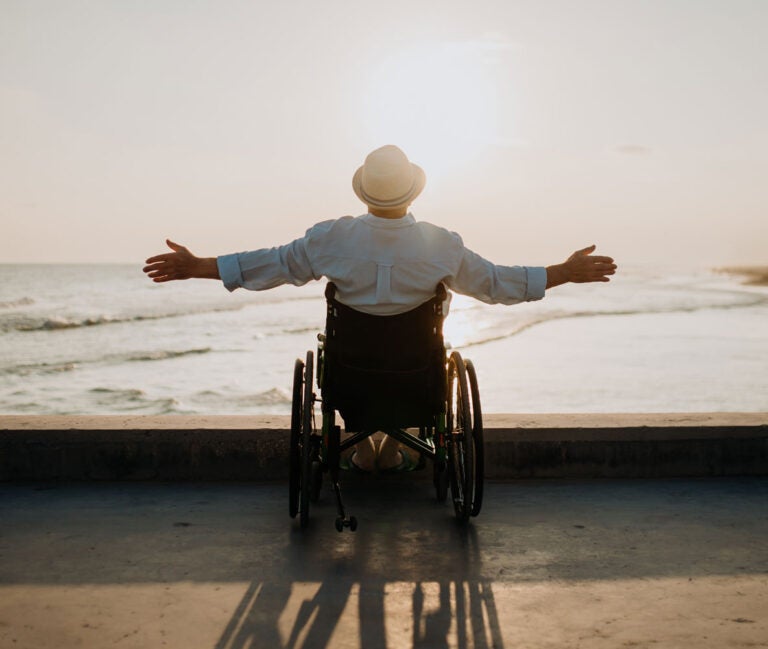As travel bounces back to pre-pandemic levels, older Americans are also looking to get out and re-experience the joys of travel. The days when you could throw a few things in a duffel and head to the airport may be gone, but a little planning can allow you to tap the spirit of spontaneity without compromising comfort and security. Just follow our handy guide to prep like a pro before you hit the road.
Before You Pack
Planning before you even start packing can help you zero in on what you’ll really need. Here are some details to consider before you load up your suitcase.
Check the Weather and Conditions
Weather can be difficult to predict, especially if you’re traveling somewhere with a different climate than you’re used to. Look up and note the extended weather forecast for your destination. Be sure to look at highs and lows to get a sense of evening and daytime temperatures. There’s nothing fun about packing light dresses for evenings on the town only to find the temperature at your destination drops after sunset.
Make a List
There’s nothing more frustrating than putting a bunch of things in your suitcase and unpacking it because you’ve forgotten what’s in there. Make a list of everything you plan to bring – clothes, shoes, medications, weather gear, toiletries, and electronics – before you even get out your bag. Then you can check them off your list as you pack.
Purchase Travel Insurance
Seriously consider travel insurance. A standard, affordable policy with trip cancellation coverage will reimburse you for your insured pre-paid and non-refundable trip costs should you cancel for reasons such as:
- Accidental injury, sickness, or death.
- Weather events (think floods, tornadoes, hurricanes) that cancel your travel plans.
- A union strike that causes your carrier to ground planes.
- Your travel supplier goes out of business, files for bankruptcy, or goes into default.
- Terrorist attacks occur in your destination city.
- Your policy can also include emergency medical benefits, so you’re covered if you face an unexpected health crisis while you’re away.
Make an Itinerary
Even though everyone has a cell phone these days, there’s no guarantee you won’t lose or drop yours just when you need it. Write or type out your full itinerary, including contact information for where you will be. Take a photo of it to keep on your phone, and print a few copies to keep and distribute. Tuck one copy in your suitcase and leave at least one copy (or email it) with someone back at home. In case something goes wrong, it’s a good idea that someone knows where you should be and when you are expected back. Don’t forget to let them know when you do get back.
What to Take, What to Leave Behind
How many times have you traveled and realized you only wore half of what you brought? The length of your journey is also a factor. You should pack far less for a four-day weekend than you would for a month abroad.
One technique for culling your carry-on is to assemble all the clothes you think you’ll want, then pull out one-third or more to leave at home. Not only will this help eliminate overpacking if you’re traveling by plane, but it could also keep you from paying extra for luggage that exceeds the weight limit.
A few special considerations to make as you plan your wardrobe:
- Will there be a laundry facility where you’re going? If so, you can easily wash and dry a load while on the road.
- Select some items that can be washed by hand in the bathroom sink and dry overnight.
- Bring clothes in neutral shades, so you have more flexibility to mix and match.
- Clothes that don’t get soiled or wrinkle easily can be worn again and again. There’s a reason jeans have become a classic!
Carrying On Vs. Checking Your Bag
If it’s a short trip, pack as economically as possible and do it all as a carry-on. For longer trips, check your main clothing bag, but make sure you have your toiletries, prescription drugs, and one change of clothes in your carry-on bag in case your checked luggage gets lost in transit. Remember, any flight that includes layovers or changing planes increases the odds of your luggage getting lost or delayed.
Jewelry and Shoes
Accessories may make the outfit, but they can also take up a lot of space in your luggage.
Shoes are heavy and bulky. Try to choose pairs that will go with multiple outfits and only one of each kind. You don’t need more than one pair of walking shoes, and a single nice pair of sandals or dress shoes should do the job for several nights on the town.
Try to keep jewelry to a minimum. Bring a couple of select pieces that go with everything and maybe one nice piece you can dress up as an outfit for a night out. Bringing more than you need leaves you vulnerable to theft or inadvertently leaving something precious behind. While some hotels supply safes for their guests, it’s also a good idea to have a lock for your suitcase that you can use if no safe is available. If you’re concerned about loss or theft, leave your favorite pieces home and plan to buy something new on the trip that you can wear and bring home as a memento.
Tech or Medical Equipment
Are you bringing a computer, smartphone, or CPAP machine? Be sure to collect all the chargers, plugs, and cords you’ll need while you’re packing. Connecting the necessary charger to the item as you pack is a good way to make sure you have them all.
It’s also a good idea to decide which of these items you’ll carry on with you and which you’ll check. Luggage gets lost less often than it used to, but it still happens. If there’s something you can’t do without, it’s probably best to carry it on. Replacing clothes is a pain, but not nearly as painful as losing a computer with all your data, an expensive camera, or a machine you need to breathe at night.
Medications
Getting medications replaced when you’re far away from your local pharmacy can be almost impossible – especially if you’re leaving the country. Depending on how essential your medications are to your wellbeing, preparing for the worst-case scenario can give you peace of mind and potentially save your life if something goes wrong on your trip.
Talk with your doctor about how long you’ll be away and how that could affect your medication needs or refills. Get a copy of all your medical information that includes your prescriptions and/or a letter explaining your condition and what medicines are used to treat it. Keep a hard copy along with a digital copy in case something happens to your luggage. If you are bringing a narcotic prescription like Vicodin or codeine, that note from your doctor explaining why you need it will be necessary to get through customs.
Always check your destination’s embassy website for drug restrictions before traveling. Some over-the-counter medications and prescriptions that are legal in the U.S. are illegal in other countries. Even some herbal medications may not be allowed overseas.
Also, look into what kind of coverage you can expect from your health insurer where you’re going. Some insurance plans provide coverage away from home and even out of the country.
When packing medications, keep the following in mind:
- Bring any prescriptions in their original pharmacy containers labeled with your name and your doctor’s. You’ll have an easier time clearing security checks.
- Bring twice the amount of medication you think you’ll need in case of flight cancellations or delays. Remember when COVID first broke out? Some people were stranded overseas for weeks.
- Pack your insurance ID cards (or a photo of them on your phone).
Bon Voyage!
Packing isn’t the most fun part of travel, but doing it well can help you avoid unnecessary stress and enjoy your trip. Follow our guide to ensure you’ve got everything covered, and wherever you’re headed, have a wonderful time!
Seniority is published by Finance of America Reverse LLC. The views expressed in this publication are those of the author alone and do not necessarily reflect the views and opinions of Finance of America Companies. This article is intended for general informational and educational purposes only and should not be construed as financial or tax advice. For more information about whether a reverse mortgage may be right for you, you should consult an independent financial advisor. For tax advice, please consult a tax professional.




